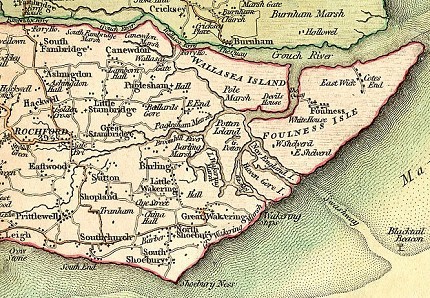The Lawless or Whispering Court was established at Kingley Wood in Rayleigh possibly as early as the 13thcentury but is certainly recorded by the early 1600s. This wood was once in Crown ownership and was also known as 'King's Wood', 'King's Hill Wood' and 'Kingsley Wood'.
The court began when the usually absent Lord of the Manor was woken up at midnight by a cockerel crowing and overheard some of his tenants plotting to kill him. As a punishment he instituted the practice of getting his tenant farmers to register to pay their rents at midnight, known as the 'lawless' hour, where they also had to swear their allegiance to their Lord in humble whispers. Latecomers and absentees were fined.
The court was moved to King’s Hill in Rochford in the 17th century. A building called 'King's Hill' and the 'Whispering Post' still exist in East Street, Rochford. The tenant farmers marked the post with the sooty embers of their burning torches to 'sign in'. The practice ceased in 1892 as it had evolved into an event instead of a court, with tenant farmers enjoying a hearty meal and plenty of ale before walking by torchlight to the Whispering Post.
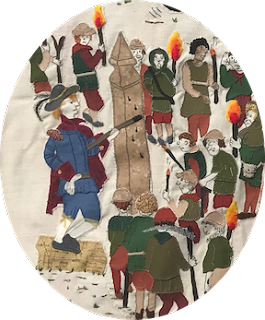
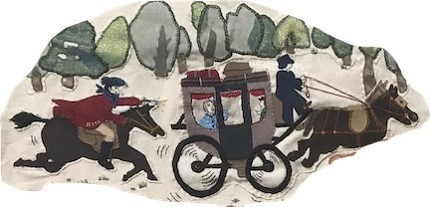
A journey by stagecoach in these times was a dangerous business, with rough and uneven 'roads' giving every possibility that the coach may topple or get stuck.
Additionally, encounters with highwaymen and footpads (highwaymen without a horse!) were once common in heavily wooded areas such as Hockley and Hawkwell.
Of course, crime was rife in towns, villages and on the rivers too. John Harriott (1745-1817), founder of both the Thames River Police, also founded the Rochford Hundred Association Against Murderers, Felons & Thieves. A bewigged Harriott is shown on the tapestry panel discussing the Association at a table at the New Ship inn, Rochford, with one of the tenant farmers who belonged to it. Similar associations include Great Wakering Prosecution Association (1787) and Rayleigh Association for the Prosecution of Felons (1794).
Not surprisingly, the aim of this group was to keep law and order. The membership fee was 10 shillings and 6 pence (52½ new pence) and the association would pay for the expenses involved in bringing offenders to justice and prosecuting them. For instance, the reward for the successful prosecution of a murderer, housebreaker, someone who set fire to a barn or haystack, or for stealing or maliciously killing a member's horse was £10. Apprehending a footpad, highwayman, poacher, or anyone who maimed a sheep, ox, bull or cow had a reward of £5. Later, hearings of the county court were held monthly at the New Ship.
The house at the bottom is Harriott's home, 'Broomhills' at Little Stambridge, which is now a care home.
Barling was home to Gallows Field and Gaol Farm. This parish once held the unusual legal right of 'furca and fossa' (gallows and pit) which allowed parishioners to hang men and dip witches.
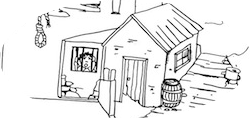
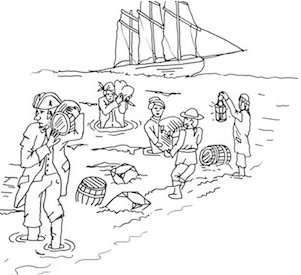
Trade, both legal and illegal, relied heavily on river and sea transport. The legitimate large trading vessels plied their trade at such seaports as Barling and Wakering, or elsewhere around our coastline.
Wreckers and smugglers were also very active, deliberately causing a ship to wreck close to shore and stealing its cargo. The rivers and creeks around the eastern edge of the District and islands like Foulness were popular with local smugglers who knew the intricacies of the channels better than the revenue men who pursued them.
Paglesham was a hotbed of smuggling, noted for its 18th century ringleader, William 'Hard Apple' Blyth (1753-1830), whose gang hid brandy barrels and other contraband in hollow trees and the local pond. Churches were also unwitting repositories for illegal goods, hidden in towers or in cavities under the pulpit!
The oyster trade became of major importance in the 18th Century using the numerous pits or lay ins that lined the creeks. By 1777 the area around the coast resembled the pattern shown today.
The emphasis shifted from fish and sheep to the more prosperous arable areas. A stock mill was erected at Barling to process the grain.
Most of the islands were now arable areas and the last island, Rushley, was reclaimed in 1781 by John Harriott who long battled to turn it over to the plough.
